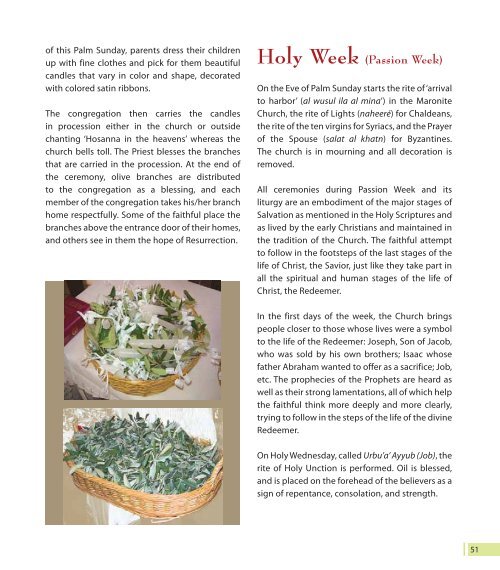Cultural aspects in Christian and Islamic religions - unesdoc - Unesco
Cultural aspects in Christian and Islamic religions - unesdoc - Unesco
Cultural aspects in Christian and Islamic religions - unesdoc - Unesco
Create successful ePaper yourself
Turn your PDF publications into a flip-book with our unique Google optimized e-Paper software.
of this Palm Sunday, parents dress their children<br />
up with f<strong>in</strong>e clothes <strong>and</strong> pick for them beautiful<br />
c<strong>and</strong>les that vary <strong>in</strong> color <strong>and</strong> shape, decorated<br />
with colored sat<strong>in</strong> ribbons.<br />
The congregation then carries the c<strong>and</strong>les<br />
<strong>in</strong> procession either <strong>in</strong> the church or outside<br />
chant<strong>in</strong>g ‘Hosanna <strong>in</strong> the heavens’ whereas the<br />
church bells toll. The Priest blesses the branches<br />
that are carried <strong>in</strong> the procession. At the end of<br />
the ceremony, olive branches are distributed<br />
to the congregation as a bless<strong>in</strong>g, <strong>and</strong> each<br />
member of the congregation takes his/her branch<br />
home respectfully. Some of the faithful place the<br />
branches above the entrance door of their homes,<br />
<strong>and</strong> others see <strong>in</strong> them the hope of Resurrection.<br />
Holy Week (Passion Week)<br />
On the Eve of Palm Sunday starts the rite of ‘arrival<br />
to harbor’ (al wusul ila al m<strong>in</strong>a’) <strong>in</strong> the Maronite<br />
Church, the rite of Lights (naheeré) for Chaldeans,<br />
the rite of the ten virg<strong>in</strong>s for Syriacs, <strong>and</strong> the Prayer<br />
of the Spouse (salat al khatn) for Byzant<strong>in</strong>es.<br />
The church is <strong>in</strong> mourn<strong>in</strong>g <strong>and</strong> all decoration is<br />
removed.<br />
All ceremonies dur<strong>in</strong>g Passion Week <strong>and</strong> its<br />
liturgy are an embodiment of the major stages of<br />
Salvation as mentioned <strong>in</strong> the Holy Scriptures <strong>and</strong><br />
as lived by the early <strong>Christian</strong>s <strong>and</strong> ma<strong>in</strong>ta<strong>in</strong>ed <strong>in</strong><br />
the tradition of the Church. The faithful attempt<br />
to follow <strong>in</strong> the footsteps of the last stages of the<br />
life of Christ, the Savior, just like they take part <strong>in</strong><br />
all the spiritual <strong>and</strong> human stages of the life of<br />
Christ, the Redeemer.<br />
In the first days of the week, the Church br<strong>in</strong>gs<br />
people closer to those whose lives were a symbol<br />
to the life of the Redeemer: Joseph, Son of Jacob,<br />
who was sold by his own brothers; Isaac whose<br />
father Abraham wanted to offer as a sacrifice; Job,<br />
etc. The prophecies of the Prophets are heard as<br />
well as their strong lamentations, all of which help<br />
the faithful th<strong>in</strong>k more deeply <strong>and</strong> more clearly,<br />
try<strong>in</strong>g to follow <strong>in</strong> the steps of the life of the div<strong>in</strong>e<br />
Redeemer.<br />
On Holy Wednesday, called Urbu’a’ Ayyub (Job), the<br />
rite of Holy Unction is performed. Oil is blessed,<br />
<strong>and</strong> is placed on the forehead of the believers as a<br />
sign of repentance, consolation, <strong>and</strong> strength.<br />
51

















